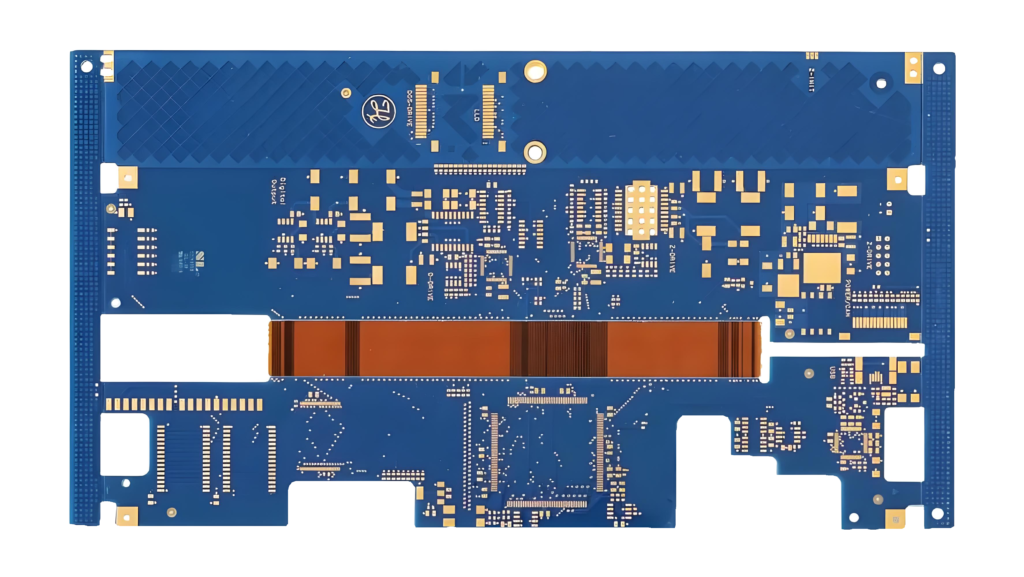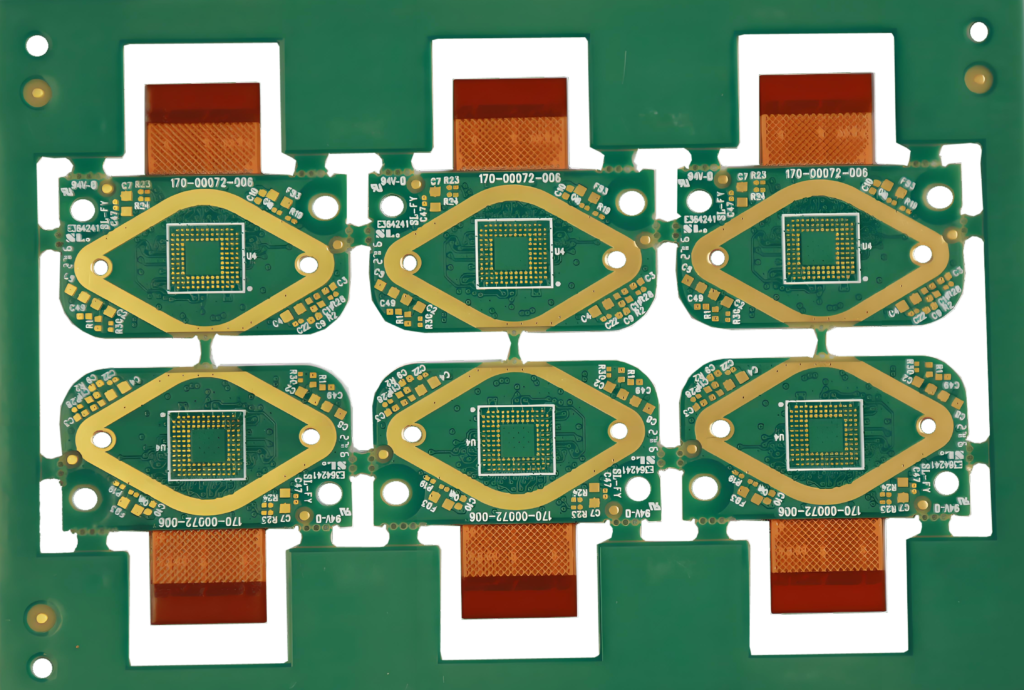Rigid-Flex PCBs
Expertise in Rigid Flex PCB Manufacturing
Top-Quality Materials: DuPont Pyralux®, Ventec ThinFlex, Panasonic FELIOS, SHENGYI SF Series Advanced Layering: 2-40 Layers Rigid Flex PCB with Blind/Buried Vias Precision Engineering: Impedance Control, Back Drill, Via Plugging Tailored Designs: Balanced & Unbalanced Structures Superior EMI Shielding: Silver Film & Silver Ink Options
Understanding the Limitations of Rigid-Flex PCBs
Complex Manufacturing Process:
Rigid-flex PCBs involve a challenging production process that requires separate fabrication of both rigid and flexible layers before they are meticulously combined. This dual-process approach demands careful attention to detail and coordination, making the manufacturing process more intricate compared to standard PCBs.Higher Production Costs:
The complexity of design and the need for specialized materials contribute to the higher production costs of rigid-flex PCBs. The requirement for skilled labor and advanced manufacturing techniques also drives up the overall expense, making these boards a premium choice for specific applications.Non-Reparable After Assembly:
Once a rigid-flex PCB is installed and assembled, it cannot be easily repaired or reworked. This lack of repairability means that any errors or issues detected post-assembly could necessitate a complete replacement, adding to the cost and time involved in production.
Request Your Free Quote Today!
Understanding Rigid-Flex PCBs
A Rigid-Flex PCB seamlessly combines the robust structure of a rigid board with the adaptability of a flexible circuit, offering both rigidity and flexibility in one versatile solution. This unique design allows for the integration of numerous electronic components on the rigid sections while enabling the flexible sections to bend and adapt during final assembly, achieving unmatched functionality.
Rigid-Flex PCBs are essential in cutting-edge electronics, including industrial automation, medical devices, telecommunications, wearable tech, automotive systems, IoT devices, robotics, military applications, and aerospace technology. LEAPPCB, a trusted manufacturer with over 16 years of experience, ensures your rigid-flex PCBs meet the highest industry standards at competitive prices. Reach out to our sales team today for an immediate quote on your rigid-flex PCB needs.
How Are Rigid-Flex PCBs Manufactured?
1. Base Material Preparation
The manufacturing process begins with preparing and cleaning the laminate, which contains copper layers coated with adhesive. The copper coils are pre-cleaned to remove any rust-proof layer applied by the supplier to prevent oxidation. This involves immersing the copper coil in a concentrated acid solution and then treating it with sodium persulfate. The coil is finally coated with an oxidizing agent for enhanced adhesion and oxidation protection.
2. Circuit Pattern Generation
Once the base material is ready, the circuit pattern is created using two main techniques:
- Silkscreening: This popular method applies the desired pattern directly onto the laminate surface, with a thickness ranging from 4 to 50 micrometers.
- Photographic Imaging: An older technique that transfers the circuit pattern from a photomask onto the laminate using a dry photoresist film and UV light.
3. Circuit Pattern Etching
After the pattern is generated, the copper laminate is etched to remove excess material. This is done by immersing the laminate in an etching bath or exposing it to an etchant spray. Both sides of the laminate are etched simultaneously for precise results.
4. Drilling
High-speed drilling tools are used to create vias, pads, and through-holes with 100% accuracy. For ultra-small holes, laser drilling technology is employed.
5. Through-Hole Plating
Through-hole plating is a critical step in the manufacturing process, ensuring electrical interconnections between layers. The drilled holes are plated with copper and chemically treated to achieve the desired layer-to-layer connections.
6. Overlay Application
A protective overlay is applied to the top and bottom sides of the rigid-flex PCB. This layer, usually made of polyimide film, safeguards the board from harsh physical and chemical conditions. The overlay is embossed onto the surface using a silkscreen technique.
7. Flex PCB Cutting
The individual flexible sheets are carefully cut. For mass production, hydraulic punching is used, while small batches are typically cut with a specialized knife.
8. Electrical Testing and Verification
The final step is to test and verify the integrity of the rigid-flex PCB. This crucial phase ensures that even the smallest defects are detected, as they could significantly impact the board’s functionality, performance, and durability.
When to Use Process Edges in Rigid-Flex PCB Production
While adding process edges to rigid-flex PCB designs can be crucial for ensuring quality and functionality, it also increases production costs. Therefore, it’s important to consider specific conditions before deciding to use them. Here’s when process edges are essential:
Component Proximity to the Edge:
If the distance between the edge of the rigid-flex PCB and the nearest components is less than 3 mm, assembly may fail. In such cases, using process edges helps create a safe distance between the components and the conveyor belt, ensuring a smooth assembly process.Lack of PCB Reference Marks:

If your PCB design lacks a reference mark, process edges become necessary to ensure that component placement is accurate and meets industry standards.
Important Considerations for Process Edges
Width of the Process Edge:
The typical width for process edges in the PCB industry ranges from 1.5 mm to 5 mm. It’s crucial to communicate clearly with downstream customers to ensure compatibility with their electronic products when using process edges.Cost Implications:
Process edges add to the production cost of rigid-flex PCBs. Therefore, manufacturers should aim to strike a balance between minimizing costs and maintaining product quality. The best approach is to consider process edges during the design phase. By planning ahead, designers can minimize the need for process edges, thereby reducing costs while still producing high-quality, reliable products.
If you have any questions or need expert advice, LEAPPCB is here to help. As one of China’s leading rigid-flex PCB manufacturers, we can offer you the best solutions to optimize your designs and reduce costs effectively.
Expanding Horizons: The Future of Rigid-Flex PCBs
When rigid-flex printed circuit boards (PCBs) first emerged, their use was limited primarily to the battery sector of smartphones. At that time, only a few major manufacturers were involved in producing these boards. However, as their applications have expanded to include mobile phones, cameras, Bluetooth headsets, and smart wearables, more PCB manufacturers have entered the market, recognizing the growing demand for rigid-flex PCBs.
Rapid Market Growth and New Opportunities Recent statistics indicate that rigid-flex PCBs have become one of the fastest-growing segments within the PCB industry. The rise of new energy vehicles and their need for advanced electronics has further fueled demand, especially in automotive applications. As electronic products continue to diversify and evolve, the market for rigid-flex PCBs is expected to broaden significantly, offering PCB manufacturers the chance to tap into high-end markets.
Increased Adoption in Consumer Electronics Rigid-flex PCBs have become a staple in consumer electronics, particularly in smartphones. As mobile devices become more complex, with multiple cameras and other advanced features, the compact and lightweight nature of rigid-flex PCBs makes them indispensable. Their usage is also extending to screens, wearable devices, and other electronics that require flexibility and durability.
Automotive Industry Embracing Rigid-Flex PCBs Unexpectedly, the automotive industry has also begun to adopt rigid-flex PCBs, particularly in car lens modules and other high-tech components. Although this market segment is still emerging, it presents significant growth potential. Smaller and medium-sized PCB manufacturers are already competing in this space, driven by the technology’s cost advantages and design flexibility.
Advantages and Market Penetration The key advantage of rigid-flex PCBs lies in their balance of design flexibility and production cost, making them a preferred choice for many electronic product manufacturers. In Asia, particularly in countries like China and South Korea, rigid-flex PCBs are extensively used in various electronic modules. Companies in these regions have quickly recognized the potential and are expanding their production capacities to meet the growing demand.
Taiwan and Mainland China Leading the Way Taiwanese companies like Xinxing and Huatong have long been leaders in the PCB market, with significant production scales and technological expertise in rigid-flex PCB manufacturing. These companies hold strong positions in the mobile phone battery and lens module markets. On the Chinese mainland, companies like Shandong Precision and JingWang are rapidly expanding their capacities, positioning themselves as major players in the rigid-flex PCB industry.
Future Outlook: A Competitive Landscape As the rigid-flex PCB market continues to grow, competition is intensifying. Large PCB manufacturers have begun to recognize the long-term potential of this technology and are entering the market with significant investments. This increased competition is expected to drive innovation and further expand the use of rigid-flex PCBs across various industries, from consumer electronics to automotive and beyond.
Understanding the Types of Rigid-Flex PCBs
Rigid-Flex PCBs are an innovative fusion of rigid and flexible printed circuit boards, designed to offer both sturdiness and flexibility in one solution. There are two main types:
Composite Rigid-Flex PCB: This type is created during the production process, where rigid and flexible layers are integrated to form a single, unified board.
Combination Rigid-Flex PCB: Here, the rigid and flexible boards are manufactured separately and then laminated together to create a cohesive circuit board.
Despite the slight differences between these two types, both are commonly referred to as Rigid-Flex PCBs. LEAPPCB specializes in fabricating Rigid-Flex PCBs with up to 40 layers, providing solutions that meet diverse industry needs. Contact us anytime for a free quote on your Rigid-Flex PCB requirements.
The Importance of Rigid-Flex PCBs
Why opt for Rigid-Flex PCBs when both rigid and flexible PCBs exist? The answer lies in their unique ability to combine the best of both worlds. Rigid-Flex PCBs offer a revolutionary way to connect electronic components, integrating the durability of rigid boards with the adaptability of flexible circuits. This combination not only reduces the need for connectors but also minimizes the size and weight of electronic devices, making them ideal for portable and advanced electronic products. As a result, Rigid-Flex PCBs are increasingly utilized in high-tech applications across various industries.
Advantages of Rigid-Flex PCB
Enhanced Reliability:
Rigid-flex PCBs offer superior reliability compared to standalone flexible PCBs. Traditional flexible PCBs require connectors, which can be cumbersome to install and prone to detachment. However, with the integrated rigid-flex design, the components are securely bonded during the lamination process, resulting in a more robust and dependable connection.Increased Production Efficiency:
The integration of rigid and flexible circuits into a single board reduces the need for connectors, significantly cutting down on assembly time and the likelihood of repair issues. This streamlined process boosts overall production efficiency, leading to faster turnaround times and reduced labor costs.Improved Signal Integrity:
Rigid-flex PCBs eliminate the need for connectors, allowing for direct connections that enhance signal integrity. This direct connection results in stronger, more reliable signal transmission, which is critical for high-performance electronic devices.Space-Saving Design:
Rigid-flex PCBs enable three-dimensional assembly, allowing for more compact and lightweight electronic products. This space-saving feature is particularly beneficial in the development of modern, miniaturized devices where every millimeter counts.
Opt for a Single-Layer Flex Structure:
When designing a circuit board that will undergo repeated bending, a single-layer flexible structure is ideal, preferably utilizing rolled annealed copper for better durability.Align Copper Traces Vertically:
Ensure that copper traces are oriented vertically relative to the bend direction. If vertical alignment isn’t possible, minimize both the bending amplitude and frequency to reduce stress on the copper.Avoid 45-Degree Angled Traces:
Steer clear of 45-degree angle traces, as they can increase stress on the copper during bending. Instead, maintain smooth, gentle curves in the traces to enhance durability.Maintain Consistent Trace Width:
Ensure that trace widths remain consistent throughout the design. Sudden changes in trace width can create weak points that are prone to damage during flexing.Reinforce Copper Layers:
Copper layers on rigid-flex PCBs are more susceptible to peeling than on rigid boards. To mitigate this, reinforce the copper layers to ensure they remain securely attached.Stagger Traces for Flexibility:
Avoid routing on both sides of the flexible section in the same location. Instead, stagger the traces to create a more even distribution of stress and enhance flexibility.Respect Bending Radius:
Pay special attention to the bending radius of the flexible layers. If the radius is too small, the board may be prone to damage. Design with a generous bending radius to ensure longevity.Optimize Layer Stackup:
The stackup of rigid-flex PCBs is crucial, with flexible layers typically placed in the middle. For example, in a 4-layer rigid-flex PCB, the flexible layers should be on layer 2 and layer 3, sandwiched between the rigid sections.
How to Get a Rigid-Flex PCB Fabrication Quote?
- Main materials (copper foil, protective film, reinforcement, backing, etc.)
- Auxiliary materials (dry film, stencil, pure film, electronic components)
- Surface finish (chemical nickel gold, electroplated nickel gold, electroplated pure tin)
- Panel utilization
- Number of board layers (single-sided, double-sided, multi-layer)
- Special requirements (line width, through-hole size, surface finish thickness, special material attachments)
- Labor costs
- Additional parts on the flexible PCB (foam, components)
Everything You Need to Know About Rigid-Flex PCBs
Yes, we provide fast-turn rigid-flex PCB manufacturing services. While our standard lead time for rigid-flex circuits is 2-4 weeks, we can also expedite the process to complete production in less than a week for urgent projects.
- Rigid-flex circuits are extensively used across various industries, including telecommunications, consumer electronics, wearable devices, IoT, robotics, industrial automation and control, automotive, medical, aerospace, and military sectors.
- Rigid-flex circuits combine the strengths of both rigid and flexible PCBs. This allows for the assembly of numerous small electronic components on the rigid parts, providing robust electronic functionality while the flexible parts offer the necessary mechanical flexibility to meet design demands.
- Absolutely. In addition to rigid-flex circuit and rigid board fabrication, we provide comprehensive PCB rigid-flex assembly services. Our engineering and production teams have extensive experience in assembling rigid-flex circuits.
Rigid-flex circuit boards are developed from rigid board technologies, merging the features of flexible circuit boards with those of rigid boards. The key differences are:
- Material Use: Rigid-flex boards incorporate flexible materials, unlike rigid boards.
- Bendability: Rigid FR4 boards are not bendable, whereas rigid-flex boards offer flexibility.
- Usage: They serve different purposes depending on the application needs.
- Cost: Rigid-flex PCBs tend to be more expensive due to their complex construction
